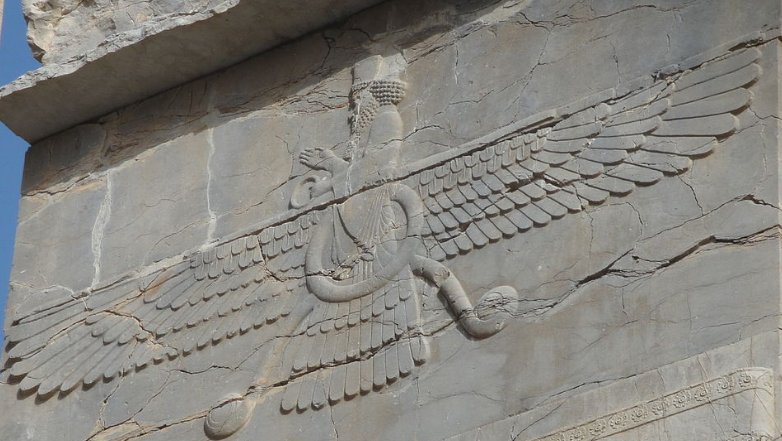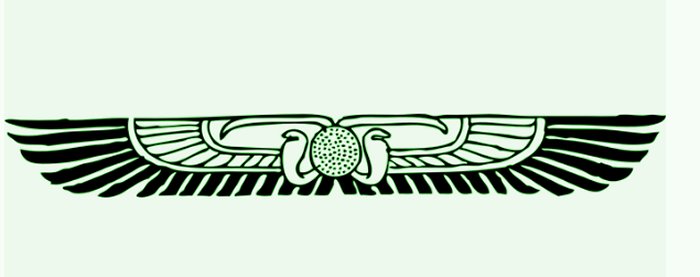Winged Sun Disk: One Of The Oldest And Most Important Solar And Religious Symbols
A. Sutherland - AncientPages.com - The winged sun disk has been found in many cultures worldwide from very ancient times. As one of the oldest religious and solar symbols, the winged sun disk was seen in many variations among the Sumerians, the Assyrians, and the Hittites, just to name a few.
The winged Sun signifies omnipresence; it is associated with divinity, royalty, and supreme power in Egypt, Mesopotamia, Anatolia, and Persia. It is interpreted as a solar globe usually carried on the hawk wings of the God Horus, surmounted by the spreading horns of the ram god Amun.
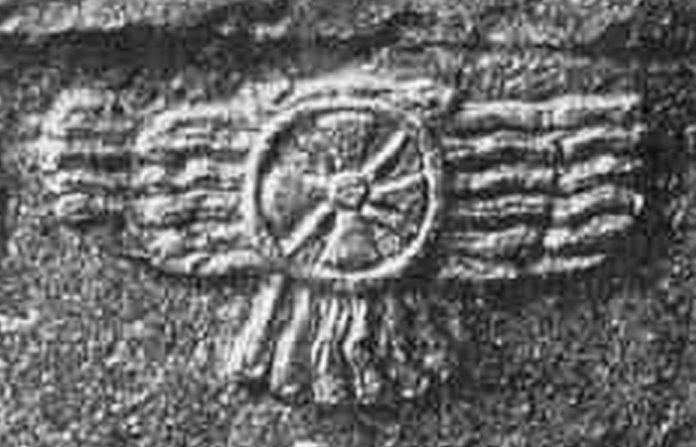 Winged Sun Disk as depicted on Stele to Assurnasiripal II at Nimrud (9th century BC). Image source
Winged Sun Disk as depicted on Stele to Assurnasiripal II at Nimrud (9th century BC). Image source
Another variation is the sun disk, flanked by two uraeus snakes (cobras) with opened hoods, sometimes wearing crowns on their heads.
The winged disk represents a singular symbol of the Savior, a winged sun, the Sun of Righteousness, arising with healing on his wings.
It is also a symbol of the sun god - Ra. 'Ra' means transforming good into nothing, disaster, and suffering in Hebrew. In China, it is a symbol of heavenly perfection, and in India and Egypt, it symbolizes a metaphorical rise in higher spheres.
In the occult, it has become a symbol of power. It is often used on tarot cards.
Winged Sun Disk In Ancient Egypt, Mesopotamia And The Levant
In ancient Egypt, the symbol is attested from the Old Kingdom (c. 2613-2181 BC) and usually flanked (on either side with a uraeus. As a symbol of protection, it has been found on stela and above temple entrances since the Middle Kingdom. It was called 'the Behdety' and as such, it was associated with the God Behdety, who (after being combined with Horus) became known as Horus of Behdet - as hawk-winged sun disc originating in the Nile Delta.
Farvahar (the "visual aspect of Ahura Mazda") i Persepolis, during the times of Zoroastrian Persia. Source
The pharaoh Akhenaten tried to eliminate all other deities and introduce the worship of the sun disk alone, personified, naturally, by himself. His attempts failed. Ancient Egypt's polytheistic system of beliefs did not accept Akhenaten's ideas and visions and erased his name from stelae.
The sun disk became the main symbol of the chief heaven god, known and worshiped under several names in Egypt. Traditionally, the sun disc was carved over doorways on many Egyptian tombs and temples.
In the Levant, Mesopotamia, and Asia Minor, the winged sun disk appeared about 2000 BC.
Assyrian rulers considered it a symbol of royalty. Its importance was expressed in words: SOL SUUS (in Latin, literally, "his own self, the Sun", i.e., "His Majesty").
Winged sun disk. Source
In the 8th century BC, the winged solar disk appeared on Hebrew seals associated with the royal house of the Kingdom of Judah, especially the symbol (together with the inscription l'melekh ("belonging to the king") was found on jars and seals from the reign of Hezekiah (715 to about 686 BC), the 13th successor of David as king of Judah at Jerusalem. Hezekiah's royal seals were decorated with six rays emanating from the central sun disk and two downward-pointing wings.
In Zoroastrianism, the winged sun disk was known as 'The Faravahar' (the "visual aspect of Ahura Mazda") during the times of Zoroastrian Persia, and some seals were found flanked on either side with the Egyptian ankh ("key of life") symbol.
The last of the Old Testament prophets, Malachi lived c. 420 BC and is considered the author of "The book of Malachi". It is the last book of the Christian Old Testament. The book of Malachi ends with God's promise to send Elijah. Jews and Christians generally agree that Elijah will return before the Messiah.
In this book, Malachi 4:2, refers to a winged "Sun of righteousness," But unto you that fear my name shall the Sun of righteousness arise with healing in his wings... "(KJV)
Updated on May 31, 2022
Written by – A. Sutherland - AncientPages.com Senior Staff Writer
Copyright © AncientPages.com All rights reserved. This material may not be published, broadcast, rewritten or redistributed in whole or part without the express written permission of AncientPages.com
Expand for referencesReferences:
Florence Nightingale on Mysticism and Eastern Religions
Alexander, Robert L. "A Hittite Cylinder Seal in the Fitzwilliam Museum." Anatolian Studies 25 (1975): 111-17. doi:10.2307/3642578.
Whitley, John B. "עיפה in Amos 4:13: New Evidence for the Yahwistic Incorporation of Ancient Near Eastern Solar Imagery." Journal of Biblical Literature 134, no. 1 (2015): 127-38. doi:10.15699/jbl.1341.2015.2633.
More From Ancient Pages
-
 On This Day In History: Ruler Of Palenque Yohl Ik’nal Was Crowned – On Dec 23, 583
News | Dec 23, 2016
On This Day In History: Ruler Of Palenque Yohl Ik’nal Was Crowned – On Dec 23, 583
News | Dec 23, 2016 -
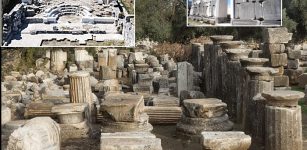 Restorations At Stratonicea Ancient City Of Gladiators In Turkish Muğla Province
Archaeology | May 10, 2023
Restorations At Stratonicea Ancient City Of Gladiators In Turkish Muğla Province
Archaeology | May 10, 2023 -
 Patara’s 2,400-Year-Old Ancient Kitchen And ‘Women’s Room’ Unearthed
Archaeology | Oct 7, 2020
Patara’s 2,400-Year-Old Ancient Kitchen And ‘Women’s Room’ Unearthed
Archaeology | Oct 7, 2020 -
 Ancient Egyptians Were Familiar With Advanced Ink Technology 2,000 Years Ago – Copper Papyri Reveals
Ancient Technology | Nov 13, 2017
Ancient Egyptians Were Familiar With Advanced Ink Technology 2,000 Years Ago – Copper Papyri Reveals
Ancient Technology | Nov 13, 2017 -
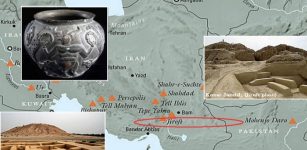 Archaeologists Survey Bronze Age Konar Sandal Site In Southeast Iran
Archaeology | Feb 17, 2021
Archaeologists Survey Bronze Age Konar Sandal Site In Southeast Iran
Archaeology | Feb 17, 2021 -
 Deciphered Ancient Stone Tablets Contain Sacred Knowledge That Could Re-Write History
Ancient Mysteries | Aug 28, 2018
Deciphered Ancient Stone Tablets Contain Sacred Knowledge That Could Re-Write History
Ancient Mysteries | Aug 28, 2018 -
 Ancient Hand Grenades: Explosive Weapons In Medieval Jerusalem During Crusades
Archaeology | Apr 26, 2022
Ancient Hand Grenades: Explosive Weapons In Medieval Jerusalem During Crusades
Archaeology | Apr 26, 2022 -
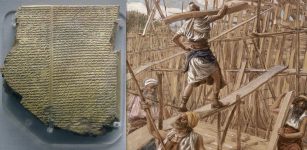 Hidden Double Message Discovered On Ancient Clay Tablet Gives A Disturbing Account Of The Great Flood
Archaeology | Dec 5, 2019
Hidden Double Message Discovered On Ancient Clay Tablet Gives A Disturbing Account Of The Great Flood
Archaeology | Dec 5, 2019 -
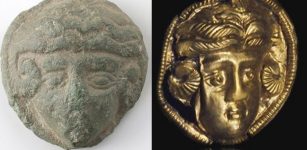 Unique Ancient Bronze Miniature Portraits Of Alexander The Great Found In Ringsted On The Island Of Zealand
Archaeology | Apr 11, 2024
Unique Ancient Bronze Miniature Portraits Of Alexander The Great Found In Ringsted On The Island Of Zealand
Archaeology | Apr 11, 2024 -
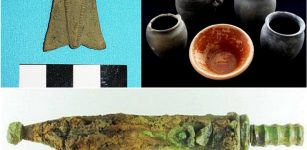 Rare Roman Brooch And A Miniature Sword – Unearthed
Artifacts | Jan 18, 2016
Rare Roman Brooch And A Miniature Sword – Unearthed
Artifacts | Jan 18, 2016 -
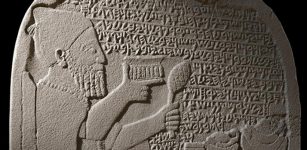 Ancient Kuttamuwa Stele And Iron Age Belief That Soul Lived In Funerary Slab
Featured Stories | Sep 10, 2016
Ancient Kuttamuwa Stele And Iron Age Belief That Soul Lived In Funerary Slab
Featured Stories | Sep 10, 2016 -
 Eleanor Of Aquitaine – Mother Of King Richard The Lionheart And One Of Most Powerful Women Of Middle Ages
Featured Stories | Feb 26, 2018
Eleanor Of Aquitaine – Mother Of King Richard The Lionheart And One Of Most Powerful Women Of Middle Ages
Featured Stories | Feb 26, 2018 -
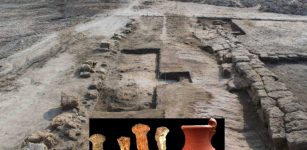 Ptolemaic Workshop For Repairing And Construction Of Boats Unearthed In Sinai
Archaeology | Feb 21, 2019
Ptolemaic Workshop For Repairing And Construction Of Boats Unearthed In Sinai
Archaeology | Feb 21, 2019 -
 7,000-Year-Old Kilns From Ceramics Workshop Unearthed In Northeast Bulgaria
Archaeology | Nov 20, 2020
7,000-Year-Old Kilns From Ceramics Workshop Unearthed In Northeast Bulgaria
Archaeology | Nov 20, 2020 -
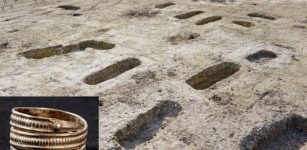 One Of The Largest Anglo-Saxon Burial Grounds Ever Uncovered In Britain Reported By Archaeologists
Archaeology | Jun 17, 2022
One Of The Largest Anglo-Saxon Burial Grounds Ever Uncovered In Britain Reported By Archaeologists
Archaeology | Jun 17, 2022 -
 1.5-Million-Year-Old Hand Axes And Hundreds Of Ancient Artifacts Found In The Iraqi Desert
Human Beginnings | Jan 31, 2025
1.5-Million-Year-Old Hand Axes And Hundreds Of Ancient Artifacts Found In The Iraqi Desert
Human Beginnings | Jan 31, 2025 -
 On This Day In History: ‘The Wars Of The Roses’ – Fighting For The Throne Of England At Tewkesbury – On May 4, 1471
News | May 4, 2016
On This Day In History: ‘The Wars Of The Roses’ – Fighting For The Throne Of England At Tewkesbury – On May 4, 1471
News | May 4, 2016 -
 Were Neanderthals Really As Well Adapted To A Life In The Cold As Previously Assumed? New Study
Archaeology | Apr 26, 2022
Were Neanderthals Really As Well Adapted To A Life In The Cold As Previously Assumed? New Study
Archaeology | Apr 26, 2022 -
 Unexpected Substance Found In Ancient Maya City May Have Arrived Through Distant Trade
Archaeology | Dec 2, 2024
Unexpected Substance Found In Ancient Maya City May Have Arrived Through Distant Trade
Archaeology | Dec 2, 2024 -
 Satellite Images Of 66 New Roman Army Sites Show More Clues About One Of The Empire’s Most Infamous Conflicts
Archaeology | Dec 23, 2020
Satellite Images Of 66 New Roman Army Sites Show More Clues About One Of The Empire’s Most Infamous Conflicts
Archaeology | Dec 23, 2020

